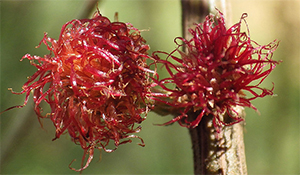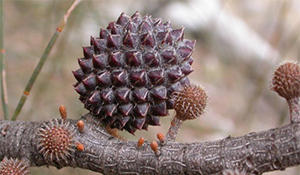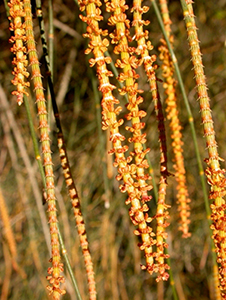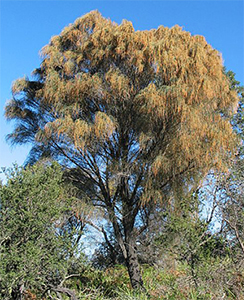Allocasuarina verticillata


Other common names
Coast She oak.
Origin of the species name
Allocasuarina alludes to the resemblance to the genus Casuarina which is from the Malayan "casuar" (a cassowary), a reference to the similarity of appearance of branchlets to the feathers of the bird; verticillata is from Latin and refers to the whorled leaves on the stem.
Family
Casuarinaceae
Date planted
July 2010 and April 2013 by the Friends of the National Arboretum Canberra.
Lifespan
Trees of this species can live to 80 years.


General description
This is a small, upright evergreen tree, usually with a rounded crown. The bark is grey-brown and furrowed. Leaves are tiny pointed scales arranged around branchlets in rings of 9–13, at 2–3 cm intervals. The pendulous branchlets are about 1.2 mm in diameter and up to 40 cm long, dull green with yellowish bands where the leaf-scales attach. On male trees, flower spikes begin to swell at the ends of branchlets in autumn and become showy orange-yellow tassels in late autumn and winter. Female trees produce small red and cream fluffy flowers on their branches in winter. These develop into brown oval seed cones, 25–50 mm long and 20–30 mm in diameter. They are covered in points which split lengthways to release dark-brown, winged seeds. Height 10m Spread 5m.
Natural distribution and habitat
This species is native to south-eastern Australia, from Tasmania north to central New South Wales, and west to South Australia where it grows in diverse habitats, from coastal headlands and plains, to rocky outcrops on inland ranges.
Conservation status
Although it is not classified as a threatened species, it is an important species for biodiversity conservation because it is the primary food source for the endangered glossy black-cockatoo. Forest 100 is one of several local plantings designed to assist the birds' survival. Many of the small isolated populations are also considered important resources for the genetic diversity of the species.
Planting pattern
Mostly planted in a diamond grid with two round open spaces, each with a central single tree.
Uses
It is valued as useful for windbreaks, drought fodder and firewood. The wood is used for posts and as a specialty timber for furniture-making.
Further reading
Boland DJ, MIH Brooker, GM Chippendale, N Hall, BPM Hyland, RD Johnston, DA Kleinig, MW McDonald and JD Turner (2006) Forest Trees of Australia (5th Edition) CSIRO Publishing.
